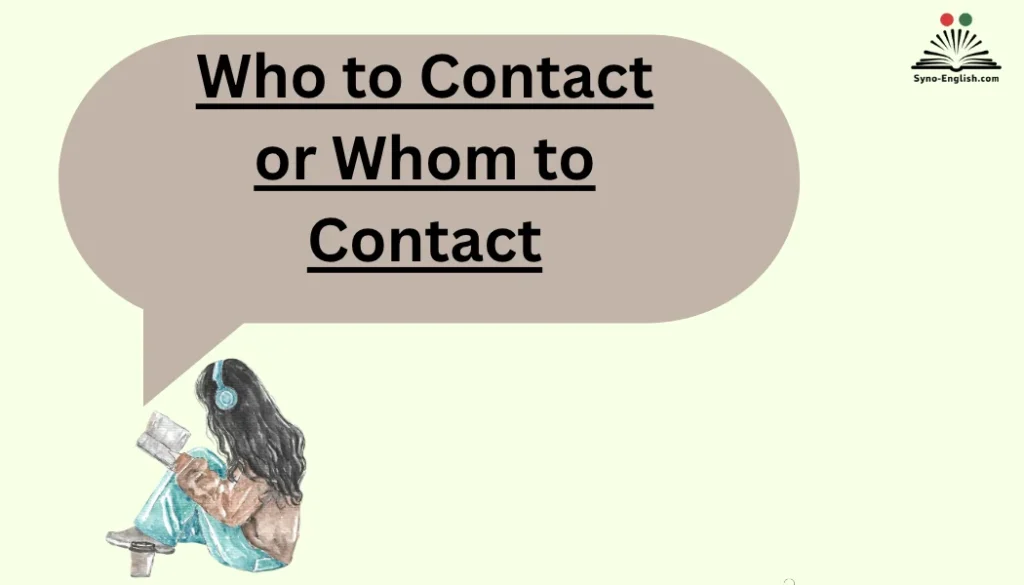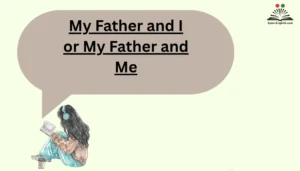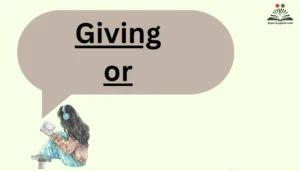The truth is that English speakers have long been debating the difference between who and whom for centuries, and this confusion still appears today in emails and writing. Who to Contact or Whom to Contact often becomes a challenge even for confident writers when drafting a message or email, as a tiny grammar point can shake one’s confidence. Having a solid guide that explains rules, mechanics, and practical methods helps you learn, feel sure, and make the right choice every time.
In modern usage and style, things have changed beyond strict traditions. Many experts focus on clarity as the most important element of good writing. Understanding the distinction between “who” and “whom” remains valuable, yet it’s also about sounding natural and clear to your reader, not only about being technically correct. As a writer, I often make adjustments in tone and word order to align with modern trends while still respecting core grammar principles.To help decide the right formwithout guessing, I often recommend easy tools, practical examples, or even a flowchart.
These approaches make learning easier, especially if you feel unsure the second time you read your sentence. In the end, what truly matters most is communicatingconfidently and achieving the important goal of good writing — clarity and connection with your audience
The Everyday Grammar Dilemma
Imagine this. You’re writing a professional email to a hiring manager:
- “Please let me know who to contact for further details.”
- Or should it be, “Please let me know whom to contact for further details”?
Both versions look correct at first glance. Many people default to “who” because it feels natural in speech. Yet in highly formal writing, “whom” may appear to be the more polished option.
So, which one should you choose? Let’s break it down from the ground up.
Breaking Down the Basics: Who vs. Whom
The difference between who and whom lies in grammar roles.
- Who = subject pronoun (does the action).
- Whom = object pronoun (receives the action).
Quick Substitution Test
A foolproof way to decide is by substitution:
- If you can replace the word with he/she/they, use who.
- If you can replace it with him/her/them, use whom.
Examples:
- “Who is calling?” → “He is calling.” ✅
- “To whom should I address the letter?” → “I should address the letter to him.” ✅
Table: Who vs. Whom Cheat Sheet
| Pronoun | Function in Sentence | Example Sentence | Substitution Test |
| Who | Subject (performs action) | “Who is responsible for this project?” | Replace with he/she → “He is responsible.” |
| Whom | Object (receives action) | “Whom did you meet yesterday?” | Replace with him/her → “You met him yesterday.” |
Why the Confusion Exists
English learners and even native speakers often stumble here. The confusion comes from several factors:
- Casual speech dominates: In conversation, most people default to “who” regardless of grammar.
- Teaching inconsistency: Some schools emphasize the distinction, while others gloss over it.
- Overlap in usage: In many sentences, “whom” feels stilted, so “who” takes over—even when technically incorrect.
- Language evolution: Just like “thee” and “thou” disappeared, “whom” is slowly fading in everyday English.
Traditional Grammar Rules
If you want to play by the book, here are the classic grammar rules.
- Who acts as the subject:
- “Who will attend the meeting?”
- Whom acts as the object:
- “Whom should I invite to the meeting?”
Subject vs. Object in Action
- Subject example: Who made the decision? (Who is the one deciding.)
- Object example: With whom are you meeting? (Whom is receiving the action of meeting.)
Modern Usage Trends
Language isn’t static. Usage evolves with culture, technology, and communication habits. Let’s see what’s happening with “whom” today.
What the Data Shows
- According to Google Ngram Viewer, “whom” has steadily declined in usage since the 20th century.
- In spoken English, “who” almost entirely replaces “whom.”
- Social media, texting, and digital communication accelerate this shift.
What Style Guides Say
- Associated Press (AP): Use “who” in most cases unless “whom” is clearly required.
- Chicago Manual of Style: Acknowledges “whom” is becoming less common, but still supports its formal use.
- Oxford English Dictionary: Notes that “whom” is now “largely restricted to formal contexts.”
Quote from Bryan A. Garner (Modern English Usage):
“Whom is in its last days. Even in writing, it often seems pompous or out of place.”
Why “Whom” Is Disappearing
There are three big reasons “whom” is vanishing:
- Natural language simplification – English tends to drop forms that feel cumbersome.
- Spoken influence on writing – Informal communication seeps into emails, blogs, and business messages.
- Generational shift – Younger speakers rarely use “whom” outside of academia.
Case Study: A 2019 survey by Merriam-Webster showed that over 60% of respondents admitted they avoid “whom” entirely because they aren’t confident using it correctly.
Professional and Formal Contexts
So, when does whom to contact actually matter?
Formal Writing Examples
- Legal documents
- Academic research papers
- Government communication
Business Communication
- In a job application:
- “Please indicate whom I should contact for further details.”
- In a casual office email:
- “Do you know who I should contact about this?”
Rule of thumb: In most workplace settings, clarity matters more than strict grammar.
Grammar in Practice: Matching Pronouns with Verbs
Grammar isn’t just theory—it’s about practical application.
Here’s a decision flowchart for quick checks:
Decision Flowchart: Who vs. Whom
Common Examples
- Correct: “To whom should I speak?”
- Common but acceptable: “Who should I speak to?”
Notice how the second is technically “wrong” but completely acceptable in modern English.
Who or Whom in Digital Communication
With the rise of social media, the rules bend even more.
- On Twitter/X: Brevity wins—“Who” is the go-to.
- On LinkedIn: Slightly more formal, but “whom” still feels pretentious.
- In texts: “Whom” almost never appears.
Example:
- Text message: “Do you know who to contact?”
- Email to professor: “Could you let me know whom I should contact?”
Language and Technology
Technology influences grammar more than most realize.
- Autocorrect and predictive text default to “who” in most contexts.
- Search engine queries overwhelmingly use “who.”
- Google Trends shows “who to contact” has thousands more searches per month than “whom to contact.”
- AI writing tools tend to mirror modern speech, recommending “who.”
Is “Whom” Still Necessary?
Here’s the big question: Do we even need “whom” anymore?
Arguments for keeping it:
- Maintains precision in grammar.
- Still required in legal, academic, and formal documents.
- Preserves the richness of English.
Arguments for letting it fade:
- Rarely used in speech.
- Creates unnecessary confusion.
- Even respected publications drop it in most cases.
Final Recommendations
So, what should you do in your writing?
- In everyday communication: Use who without guilt.
- In formal or academic contexts: Use whom when clearly required (object of a verb or preposition).
- If in doubt: Reword the sentence for clarity.
Simple Rule of Thumb
- If you’re writing a text, tweet, or casual email: who to contact.
- If you’re writing a legal brief, academic paper, or official proposal: whom to contact.
Example Rewording for Clarity:
Instead of writing: “Please advise whom I should contact.”
Write: “Please tell me the right person to contact
Conclusion
Mastering the difference between who and whom is more than just a grammar lesson—it’s about building clarity and confidence in your writing. When we ask “Who to Contact or Whom to Contact,” we’re not only learning rules but also applying modern usage that fits natural communication. Understanding the distinction between the two gives your words accuracy while maintaining flow and tone. Whether you’re drafting an email, preparing a formal message, or writing online, using the right form shows your attention to style and professionalism. The truth is that even experienced English speakers sometimes get tripped up by such tiny grammar points, but the guide, examples, and flowchart we discussed help you decide easily and confidently.
In today’s modern writing, correctness and clarity should coexist. Knowing when to use “who” or “whom” is an important skill, but your focus should always be on your reader’s understanding. By applying these practical tools, you’ll learn to recognize patterns, adapt to context, and write more naturally. Remember, good grammar isn’t about rigidity—it’s about effective communication. So the next time you pause mid-sentence wondering which to choose, trust your understanding of grammar mechanics and your instinct for clear expression. Both will lead you toward confident, meaningful, and good writing that reflects precision and personality.
FAQs
What is the main difference between who and whom?
“Who” acts as a subject, while “whom” is used as an object in a sentence.
When should I use ‘whom’?
Use “whom” when referring to the object of a verb or preposition.
Is using ‘whom’ still necessary today?
It’s becoming less common, but it’s still valued in formal writing.
How do I know if I’m using the correct word?
Try replacing it with “he/she” or “him/her” — if “him/her” fits, use “whom.”
Do people care about this rule anymore?
Yes, especially in professional or academic writing where precision matters.
Why do many writers confuse who and whom?
Because modern English often drops “whom,” leading to less exposure to its use.
Can I use who instead of whom?
In casual speech, yes—but in formal contexts, “whom” is preferred.
How can I practice using them correctly?
Write example sentences and check if “who” or “whom” fits based on the subject/object rule.
Does ‘whom’ make writing sound old-fashioned?
Sometimes, but it also makes writing sound polished and grammatically correct.
What’s the best way to remember the rule?
Think: “Who = he/she,” “Whom = him/her.” That simple memory trick never fails.

Emma Brooke is a passionate English educator, writer, and language enthusiast with over a decade of experience helping learners master the nuances of the English language. At SynoEnglish, she blends practical grammar advice with real-world communication tips to make English easier, clearer, and more enjoyable for readers of all levels.



